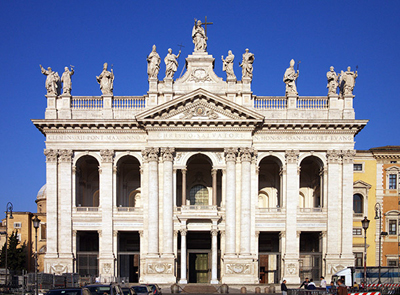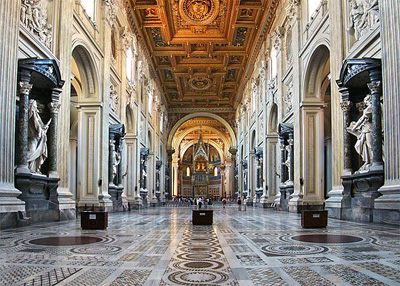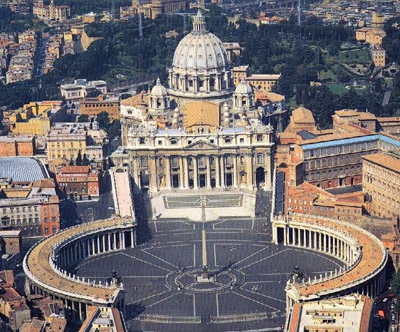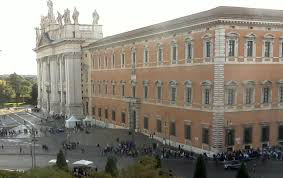Special Feast Days
 |
 |
 |
 |
 |
 |
 |
Dedication of the Lateran Archbasilica –
November 9
November 9 commemorates the day of the dedication of the Basilica of the Most Holy Savior, called the mother and seat of all the churches, the Lateran Church. It is the only church in the Catholic world with the title of Arcbasilica.
I have before me a historic note that reads: On November 9, 324, Pope Sylvester I presided over the official dedication of the Basilica of Lateran. In 315 Emperor Constantine had ordered the construction of the Basilica.
You remember that Constantine was the Emperor who freed the Church and took her out of the Catacombs. So, consistent with that gesture, he ordered the construction of the Basilica.

 That site had been the Palace of the Laterani family in Rome for a long time; then, because of its location on top of a hill, it became a fort for the Roman imperial cavalry bodyguards. Through his wife Fausta, the property fell into the hands of Constantine, who transformed it, first, into a palace for his family; then, after donating it to the Church, he made it a Basilica. Pope Sylvester consecrated the Basilica to the Holy Savior in 324 and it became the Cathedral of the Pope.
That site had been the Palace of the Laterani family in Rome for a long time; then, because of its location on top of a hill, it became a fort for the Roman imperial cavalry bodyguards. Through his wife Fausta, the property fell into the hands of Constantine, who transformed it, first, into a palace for his family; then, after donating it to the Church, he made it a Basilica. Pope Sylvester consecrated the Basilica to the Holy Savior in 324 and it became the Cathedral of the Pope.
You can imagine the emotion of Catholics, who, after centuries of persecution and the life of the catacombs, finally saw a grandiose basilica raised up that affirmed the splendor of the Catholic cult in the most important city of the world. You can envision their joy seeing the public attestation that Our Lord Jesus Christ was the true Savior of mankind.
In Rome itself, the adoration for Our Lord became manifest before the eyes of all and was received with admiration, while the pagan cult was proscribed and outlawed. It was something similar to what the first moments of the Reign of Mary will be. Few things can give more an idea of what the true Catholic joy is than that episode.
The historical note continues: For a long time, the Popes made their residence in a Palace that was an extension of the Basilica. The Basilica became their cathedral, and for this reason was called the mother and the head of all churches of the world. Two fires ravaged the Archbasilica in the 14th century and it fell into deterioration when the Popes moved to Avignon. Pilgrims who visited Rome would find the churches there filled with grass and cattle grazing inside them. Chickens, doves and other animals were living inside the churches and using the altars as shelters…
You see the rotations of History. The Catholic Church leaves the catacombs radiant. She raises an immense building; afterwards, inside that building cows come to graze because the Shepherds are in Avignon. You see the turns of History.
The note continues: Later the Basilica was re-consecrated, this time in honor to St. John the Baptist and St. John the Evangelist.
Thus, the Basilica of the Holy Savior has these two secondary patron saints.
 Whoever visits Rome notices a remarkable difference between the Lateran Basilica and the Vatican Basilica. St. Peters' Basilica has a new and showy air, with all the splendor of the Renaissance. Looking at it we have the idea of a wedding feast.
Whoever visits Rome notices a remarkable difference between the Lateran Basilica and the Vatican Basilica. St. Peters' Basilica has a new and showy air, with all the splendor of the Renaissance. Looking at it we have the idea of a wedding feast.
The Lateran Basilica is much less sensational. Much more discrete, it has a tone of old nobility, with its grandeur and peace. It is, as it were, conscious of its own dignity. This is an ambience that St. Peter Basilica's does not have.
St. Peter's Basilica is anxious to make a grand show to win the admiration of those who visit it. Not so with the Lateran Basilica. It is conscious of its own dignity, it stands stately and solemn as if it were saying: “I am like this naturally. I do not embellish myself, I have no need for artifices; I am what I am. But being what I am, I am worthy of respect and admiration.” This is the impression we have of this Basilica. An impression that is totally different from that we receive looking at St. Peter's Basilica.
These edifices show two different faces of the Church. In one period of History we see her organic spontaneity, dignity and composure; then, the winds of the Renaissance enter bringing a different spirit and another way of presenting herself.
 Today, unfortunately, in front of the Lateran Basilica we find a crossroad of streets with a very intense traffic, which breaks the normal recollection of that edifice. So, we find the Basilica with her distinction as Queen, a very genuine, maternal Queen. Then, right in front of it is a frenetic movement of buses, cars and scooters, a multitude of people and rabbles of tourists from Europe and the entire world. Very few of them really look at the Basilica. People pass by in a hurry thinking of other things.
Today, unfortunately, in front of the Lateran Basilica we find a crossroad of streets with a very intense traffic, which breaks the normal recollection of that edifice. So, we find the Basilica with her distinction as Queen, a very genuine, maternal Queen. Then, right in front of it is a frenetic movement of buses, cars and scooters, a multitude of people and rabbles of tourists from Europe and the entire world. Very few of them really look at the Basilica. People pass by in a hurry thinking of other things.
Today, almost no one understands that Queen because people have lost the capacity to understand it. They do not have eyes to see and the intelligence to understand. Most curiously, even the European tourists who go there specifically to visit it, look at it, but what they really admire is the “paradise” of technology of the external world.
Here we have two Europes in conflict: the old Europe represented by the Lateran Basilica, and the new Europe of the adorers of the modern life.
This lack of admiration portends the eventual demolition of the monument. First, the decision will be made to transform the monument into an institution of charity or a museum. Then, for practical reasons, someone will propose: “Why don’t we demolish this building and replace it with a 50-story-building? It will be much more profitable for everyone, including the Church… It can still house all the museum objects with plenty of room left for many other good purposes.” The building disappears and is replaced by something without any history.
Is this not what is being prepared for the Lateran Basilica, and even for the Vatican Basilica? Qui lo sà? Who knows?


The Saint of the Day features highlights from the lives of saints based on comments made by the late Prof. Plinio Corrêa de Oliveira. Following the example of St. John Bosco who used to make similar talks for the boys of his College, each evening it was Prof. Plinio’s custom to make a short commentary on the lives of the next day’s saint in a meeting for youth in order to encourage them in the practice of virtue and love for the Catholic Church. TIA thought that its readers could profit from these valuable commentaries.
The texts of both the biographical data and the comments come from personal notes taken by Atila S. Guimarães from 1964 to 1995. Given the fact that the source is a personal notebook, it is possible that at times the biographic notes transcribed here will not rigorously follow the original text read by Prof. Plinio. The commentaries have also been adapted and translated for TIA’s site.
I have before me a historic note that reads: On November 9, 324, Pope Sylvester I presided over the official dedication of the Basilica of Lateran. In 315 Emperor Constantine had ordered the construction of the Basilica.
You remember that Constantine was the Emperor who freed the Church and took her out of the Catacombs. So, consistent with that gesture, he ordered the construction of the Basilica.

The Archbasilica of the Most Holy Savior & of St. John the Baptist & St. John the Evangelist in the Lateran

You can imagine the emotion of Catholics, who, after centuries of persecution and the life of the catacombs, finally saw a grandiose basilica raised up that affirmed the splendor of the Catholic cult in the most important city of the world. You can envision their joy seeing the public attestation that Our Lord Jesus Christ was the true Savior of mankind.
In Rome itself, the adoration for Our Lord became manifest before the eyes of all and was received with admiration, while the pagan cult was proscribed and outlawed. It was something similar to what the first moments of the Reign of Mary will be. Few things can give more an idea of what the true Catholic joy is than that episode.
The historical note continues: For a long time, the Popes made their residence in a Palace that was an extension of the Basilica. The Basilica became their cathedral, and for this reason was called the mother and the head of all churches of the world. Two fires ravaged the Archbasilica in the 14th century and it fell into deterioration when the Popes moved to Avignon. Pilgrims who visited Rome would find the churches there filled with grass and cattle grazing inside them. Chickens, doves and other animals were living inside the churches and using the altars as shelters…
You see the rotations of History. The Catholic Church leaves the catacombs radiant. She raises an immense building; afterwards, inside that building cows come to graze because the Shepherds are in Avignon. You see the turns of History.
The note continues: Later the Basilica was re-consecrated, this time in honor to St. John the Baptist and St. John the Evangelist.
Thus, the Basilica of the Holy Savior has these two secondary patron saints.

St. Peter's Basilica built with the Renaissance spirit
The Lateran Basilica is much less sensational. Much more discrete, it has a tone of old nobility, with its grandeur and peace. It is, as it were, conscious of its own dignity. This is an ambience that St. Peter Basilica's does not have.
St. Peter's Basilica is anxious to make a grand show to win the admiration of those who visit it. Not so with the Lateran Basilica. It is conscious of its own dignity, it stands stately and solemn as if it were saying: “I am like this naturally. I do not embellish myself, I have no need for artifices; I am what I am. But being what I am, I am worthy of respect and admiration.” This is the impression we have of this Basilica. An impression that is totally different from that we receive looking at St. Peter's Basilica.
These edifices show two different faces of the Church. In one period of History we see her organic spontaneity, dignity and composure; then, the winds of the Renaissance enter bringing a different spirit and another way of presenting herself.

Amid traffic and crowds, Lateran Basilica's grandeur goes unnoticed
Today, almost no one understands that Queen because people have lost the capacity to understand it. They do not have eyes to see and the intelligence to understand. Most curiously, even the European tourists who go there specifically to visit it, look at it, but what they really admire is the “paradise” of technology of the external world.
Here we have two Europes in conflict: the old Europe represented by the Lateran Basilica, and the new Europe of the adorers of the modern life.
This lack of admiration portends the eventual demolition of the monument. First, the decision will be made to transform the monument into an institution of charity or a museum. Then, for practical reasons, someone will propose: “Why don’t we demolish this building and replace it with a 50-story-building? It will be much more profitable for everyone, including the Church… It can still house all the museum objects with plenty of room left for many other good purposes.” The building disappears and is replaced by something without any history.
Is this not what is being prepared for the Lateran Basilica, and even for the Vatican Basilica? Qui lo sà? Who knows?

 | |
|
|
The texts of both the biographical data and the comments come from personal notes taken by Atila S. Guimarães from 1964 to 1995. Given the fact that the source is a personal notebook, it is possible that at times the biographic notes transcribed here will not rigorously follow the original text read by Prof. Plinio. The commentaries have also been adapted and translated for TIA’s site.


